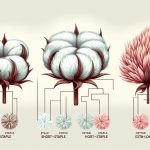Are you curious to know if leather is considered a non woven fabric? In this article, we will explore the definition of non woven fabric and the characteristics of leather. We will also discuss how non woven fabrics are made and the properties of non woven fabrics. Additionally, we will compare leather to non woven fabrics and examine the use of leather in non woven products. So, let’s dive in and unravel the truth about leather and its classification as a non woven fabric.
Table of Contents
The Definition of Non Woven Fabric
Non woven fabric is a material that is made without weaving or knitting. It is a versatile and innovative material that is used in a wide range of applications. Non woven fabric is made by bonding together fibers, either through mechanical, thermal, or chemical processes. This manufacturing process creates a fabric that has a unique structure and properties.
The definition of non woven fabric is important to understand because it distinguishes it from other types of fabrics. Unlike woven or knitted fabrics, which are made by interlacing yarns together, non woven fabric is made by directly bonding fibers together. This results in a fabric that is lightweight, durable, and highly functional.
The manufacturing process of non woven fabric involves several steps. First, the fibers are selected and prepared. They can be made from various materials, such as polyester, polypropylene, or nylon. Next, the fibers are laid out in a random or ordered arrangement. Then, they are bonded together using heat, pressure, or chemicals. This bonding process creates a fabric that is strong and stable.
Characteristics of Leather
Leather is known for its durability and natural flexibility. When it comes to durability, leather is hard to beat. It can withstand wear and tear, making it a long-lasting material. Leather products, such as jackets, bags, and shoes, can withstand years of use without losing their shape or quality. This durability is due to the inherent strength of the leather fibers, which are tightly woven together.
In addition to its durability, leather is also a sustainable material. It is made from the hides of animals, which are a byproduct of the meat industry. Using the hides ensures that no part of the animal goes to waste. Furthermore, leather can be recycled and repurposed, reducing the need for new materials.
Leather is also a natural material, which means it is biodegradable. Unlike synthetic materials, leather will break down over time, returning to the earth without causing harm to the environment. This makes it a more sustainable choice compared to materials that take hundreds of years to decompose.
How Non Woven Fabrics Are Made
Cotton and other natural fibers are often used in the production of non-woven fabrics. Non-woven fabrics have several advantages over traditional woven fabrics.
First, non-woven fabrics are cost-effective. They can be produced at a lower cost compared to woven fabrics. Additionally, non-woven fabrics are versatile and can be customized to meet specific requirements. They can be made to be lightweight, durable, and resistant to water and chemicals.
The production process of non-woven fabrics involves three main steps: web formation, web bonding, and finishing. In the web formation stage, fibers are first laid out in a random or uniform pattern. This can be done using various methods such as carding, airlaid, or wet-laid processes.
The next step is web bonding, where the loose fibers are bonded together to form a cohesive fabric. This can be achieved through mechanical bonding (needle punching or hydroentanglement), thermal bonding (using heat or ultrasonic waves), or chemical bonding (using adhesives).
Finally, the finished non-woven fabric undergoes finishing processes such as dyeing, printing, or coating to enhance its appearance or functionality.
Properties of Non Woven Fabrics
Polyester is a common material used in the production of non woven fabrics due to its durability and resistance to water and chemicals. Non woven fabrics have several properties that make them versatile and suitable for various applications.
Here are some key properties of non woven fabrics:
-
Breathability: Non woven fabrics are known for their breathability, allowing air to pass through easily. This property makes them suitable for use in products such as face masks and medical gowns.
-
Strength: Non woven fabrics exhibit excellent strength and tear resistance. This makes them durable and long-lasting, even under heavy usage.
-
Absorbency: Depending on the manufacturing process, non woven fabrics can be designed to have high absorbency, making them suitable for use in products like diapers and sanitary napkins.
-
Easy to Clean: Non woven fabrics are generally easy to clean and maintain. They can be washed and dried without losing their shape or integrity.
-
Manufacturing Process: Non woven fabrics are produced by bonding or interlocking fibers together, rather than weaving or knitting them. This manufacturing process allows for flexibility in design and customization.
Comparing Leather and Non Woven Fabrics
When it comes to comparing materials, you’ll find that non woven fabrics offer unique properties that set them apart. In the case of comparing leather alternatives, non woven fabrics have gained popularity due to their versatility and environmental impact. Non woven fabrics are made by bonding fibers together using heat, chemicals, or mechanical processes, rather than weaving or knitting. This means they can be produced at a lower cost and with less waste compared to leather.
Additionally, non woven fabrics can be designed to mimic the look and feel of leather, making them a viable alternative for those looking for a more sustainable option.
One of the main advantages of non woven fabrics over leather is their reduced environmental impact. Leather production requires the use of animal hides, which contributes to deforestation, water pollution, and the emission of greenhouse gases. On the other hand, non woven fabrics can be made from recycled materials, such as plastic bottles or textile waste, reducing the need for new resources and diverting waste from landfills.
Furthermore, non woven fabrics are often biodegradable or recyclable, making them a more sustainable choice in terms of end-of-life disposal.
The Use of Leather in Non Woven Products
When it comes to the use of leather in non-woven products, it is important to consider the durability and sustainability of this material.
Leather is known for its exceptional durability, making it a reliable choice for various applications.
Additionally, leather can be a sustainable option if sourced responsibly and processed using environmentally friendly methods.
Durability of Leather
Leather is known for its durability, making it a great choice for long-lasting products. When it comes to durability, leather has several advantages over other materials:
- Resistance to wear and tear: Leather can withstand rough use and is less likely to show signs of damage compared to other fabrics.
- Longevity: Leather products can last for years or even decades with proper care, making them a sustainable option.
- Natural aging: Over time, leather develops a unique patina that adds character and enhances its appearance.
However, it’s important to consider the environmental impact of leather production. The process of tanning leather involves the use of chemicals that can be harmful to the environment if not properly managed. Additionally, the demand for leather contributes to the livestock industry, which has its own environmental consequences.
Overall, while leather offers exceptional durability, it’s crucial to weigh the environmental impact and consider sustainable alternatives when possible.
Sustainability of Leather
Now let’s consider the sustainability of leather and the ethical concerns associated with using it.
When it comes to sustainability, leather is often seen as a controversial material. On one hand, leather is a natural and biodegradable material, which means it has the potential to be sustainable. However, the production of leather involves a significant amount of resources, including water, energy, and chemicals.
Additionally, the leather industry has been linked to deforestation, pollution, and unethical practices towards animals. Many people have raised concerns about the treatment of animals in the leather industry, particularly in regards to animal welfare and the use of exotic skins.
As a consumer, it is important to be aware of these ethical concerns and to make informed decisions about the use of leather products.
Conclusion
In conclusion, leather is not classified as a non-woven fabric. Non-woven fabrics are made by bonding or interlocking fibers, while leather is a material made from animal hide.
Leather has its own unique characteristics and properties that make it different from non-woven fabrics. Although leather can be used in the production of non-woven products, it does not fall under the category of non-woven fabric itself.
It is important to understand the distinctions between different materials to make informed decisions in product manufacturing.
- How Does Ring Spun Cotton Affect Garment Fit and Shape Retention? - August 13, 2024
- What Are the Challenges in Producing Ring Spun Cotton? - August 13, 2024
- Is Ring Spun Cotton Suitable for Plus-Size Clothing? - August 13, 2024



